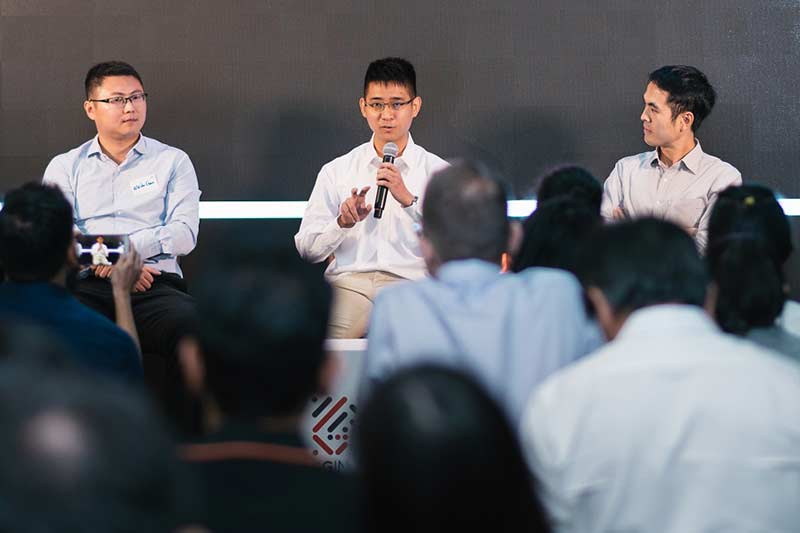
In the traditional drug development process, it takes years or even decades to translate medical research into drugs available in the market. Dr. Yok Hian Chionh
believes that this system is due for a change. He believes that the war against infections can be won if we proactively create
systems that rapidly design cures, respond to, and treat patients during
outbreaks. He is exploring radically different science-based regulatory
frameworks to expedite regulatory approvals of therapeutics, while meeting safety
and efficacy requirements.
As a scientist, Dr. Chionh
discovered fundamental properties of genetic coding that enabled pathogens to
survive hostile environments. As a drug developer, he helped bring an anti-Zika
therapeutic from bench-to-bedside within a significantly reduced timeframe as
compared to the usual process.
Dr. Chionh is one of the 10 young Innovators under 35 in Asia recognised
by the MIT Technology Review. A former fellow of the Singapore MIT
Alliance for Research and Technology, he is currently an Assistant Director of
start-up Tychan Pte. Ltd., which has established a toolkit of platform technologies to rapidly bring promising therapeutics from bench-to-bedside using integrated analytics, accelerated bio-manufacturing, progressive clinical trial design and evidence-based regulatory frameworks.
Following the announcement in November
2017, OpenGov spoke to Dr. Chionh to learn more about the problems with current
regulatory frameworks and how they can be addressed.
The current regulatory framework- a globally harmonised system
The medical sector is
highly regulated and conservative. Current regulatory frameworks in countries around the world are harmonised.
It’s a systematic approach towards ensuring that every single drug manufactured
is exactly the same. There are no permitted
exceptions. For trials, there’s an established sequential process, starting
with a small group, moving on to bigger groups and finally going to market.
To bring about a
change, you need evidence. If equivalence can be proven among different tests
or different products, then it can be effectively communicated that they are
one and the same [1].
Dr. Chionh explained that
everything is put in place for a reason.
There are two
sets of reasons, historical and administrative. In early systematic drug trials,
public safety issues were not always addressed appropriately. To prevent those
issues from cropping up, new rules were imposed based on the experience.
Secondly,
to harmonise the frameworks across different countries across say the European,
American and Japanese regulations, there is tendency to cross-apply all the
rules.
“I have
rule A, you have rule B, and we apply both rule A and B to all the drugs that
comes into our countries, as simple as that. It’s an oversimplification, but
that’s the general idea,” Dr. Chionh said.
The new approach
But in the
context of epidemics or infectious diseases and drug resistance, a new approach
is needed in order to save lives now. It's not a matter of one or two lives. Thousands of lives could be at stake.
Dr. Chionh said, “In those situations, we cannot wait
for five years to conduct the research and get the product to market. People need the drugs now. That is what the
radically different approach is. It is really common-sense. You do not want to
do things in a stepwise manner and wait for the results from A, before you do
B, when we can do A and B at the same time.”
In those
situations, we cannot wait for five years to conduct the research and get the
product to market, because people need those drugs now. The radically different
approach is about doing that, about getting those drugs to the market and to
people in the shortest possible timeframe.
Dr. Chionh
said. “It is really common sense; we do not want to do things in a step-wise
manner and wait for the results – wait for A, before we do B when we can do A
and B at the same time.” So, there
are better ways to do things right now.”
But for profit-driven
companies, it is difficult because of often they need to wait for A before they
can invest in B.
“If it’s purely
profit driven and rules driven, we cannot address major challenges that the
world is currently facing. But if we say that, “Ok guys, this rule makes sense,
but this rule doesn’t apply because of the structure, context, or the disease
we are treating, and we justify why we address this this way, you’ll find that
regulators are very receptive.” So, the interests can still coincide.
Evidence from big data
We asked
Dr. Chionh about the applicability of this new approach. Can the approach be generalized
or is it applicable only in certain specific situations?
Dr. Chionh replied
that the answer is a bit of both. There is general applicability in areas like biologics
versus small molecules [2], that can
be generalised across the board. For example, the field of biologics is witnessing
rapid growth and computation can be used to design perfect counters against a
virus, saving a lot of time in drug screening.
There are
other instances, where big data can be used to provide evidence for what works
and what does not.
“This is
where we need to clearly state what the context is, why some things are
addressed in a certain way and this is where we provide evidence for using big
data. There’s data out there and we have generated our own data, you can show
that all this data, in general, makes a logical, sound and systematic argument.
This works, this does not work, we can show you why, that’s what we’re trying
to do.”
Is there enough data?
In fact,
there’s too much of it. And sometimes it is difficult to ensure that there is
no bias in the data selection.
“We
generate our own (data) because we want to be sure of the way it’s selected,
the way it’s designed. Because most of the time if you look at data, it’s
biased, it’s like going to a shopping mall and say, I want to buy potato chips
and you get potato chips but you ignore all the other chips out there. This is
what we want to avoid,” said Dr. Chionh.
He went on
to say, “So, we come from a rather bottom-down perspective – this is the end
goal, these are the things in place, let’s go through the data analytics, have
it such that we can see a clear path. Sometimes it means doing the things
everyone is doing, that’s fine, because the data supports it. Sometimes it
means that this is not going to work, let’s use another way to do it.”
The way ahead
Starting
from the 1980s, systematically over a period of 30 years, AIDs has turned from
an incurable disease to one which can be controlled (The life
expectancy for someone living with HIV, who is on anti-retroviral treatment
and responding to treatment, is no different to the general population.)
Dr. Chionh believes
that the next round of innovation can make such processes faster, such that not
just people tomorrow, but also we, the people today, can benefit from the new
drugs.
[1] Two pharmaceutical products are
bioequivalent if they are pharmaceutically equivalent and their bio-availabilities
– rate and extent of availability, after administration in the same dose are
similar to such a degree that their effects, with respect to both efficacy and
safety, can be expected to be essentially the same.
[2] Small,
chemically manufactured molecules are the classic active substances in
drugs and continue to constitute the majority of the drug market. In contrast, biologics
are a class of drugs based on proteins that have a therapeutic effect. These
large protein molecules can be described as copies or optimised versions of
endogenous human proteins.
















